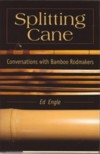Books about Bamboo Rod Building

Splitting Cane: Conversations with Bamboo Rodmakers
by Ed EngleEdition: Hardcover
Ed Engle enjoys fly-fishing and especially bamboo rods. His appreciation for the rod builder and the finished product is clear and present throughout this book. You learn as much about the rod builder as you do about their finely crafted rods in each chapter. Engle's treatment is exactly right here . you can't consider one without the other. But you should realize the chapters are written much less as a critique and more of a celebration of the rod and its maker.
Each of the chapters of Splitting Cane derives from magazine articles the author wrote for Anglers Journal. An apparent boilerplate is used to create many of the chapters. It goes something like this: "I meet rod maker XYZ through a friend of a friend. He sent me a rod to cast. I tested it out on the lawn in front of my house. It casted.... So, Mr. XYZ how did you get into building bamboo rods, etc." The last five chapters of the book provide solid references from where the raw material is grown to how to get started building bamboo rods.
In general, the publisher, editor, and author missed the mark. To imagine a book without any color photos of the actual bamboo rods seems wrong . almost criminal. Instead the author serves up fairly sober descriptions of the rods appearance in page after page of text. No, the only color image you'll get of a bamboo rod length is on the jacket cover of this book.
What a shame, I really wanted to like Splitting Cane. But imagine an art book (and yes, bamboo rods combine art and function) without any photos of the artists' works. The result is similar. To quote from one of the rod makers in the book: "Rods not only have to be functional, they almost have to be works of art." -- Jeff Wagner.
And it doesn't appear the color plates were axed to save on the cost of printing the book. Stackpole lists a single copy for around 30 dollars. I suggest the author revise the work and get the publisher to deliver on the real potential for bamboo rods to inspire the reader/angler.
The Angler's Bamboo
by Luis MardenEdition: Hardcover

I received Angler's Bamboo as a gift from my cousin, Gib Cooper who along with his wife owns and operates Tradewinds Bamboo Nursery out of Gold Beach, Oregon. The book provides a concise history of how "tea stick bamboo" came to be revered by anglers around the world.
What the Chinese had known before the birth of Christ, Western civilization came to know much, much later. Of all the known natural materials that are lightweight, and small in diameter, bamboo proved to one of the strongest. As Marden explains:
"Fibrovascular bundles (the rod maker's 'power fibers') stronger than steel, concentrated toward the outer surface of the hollow bamboo culm, or stalk, grow in parallel bundles held in a pithy matrix, giving bamboo it's qualitites of lightness and strength."
He credits the first fishing rod consulted of entirely split bamboo coming out of England around 1830. And not many years after that, "the father of the split-bamboo rod" across the pond is Samuel Phillippe, a gunsmith by trade. By 1845 Phillippe is constructing entire rods of four-strip sections. The origin of the six-strip hexagonal rod is commonly credited to another American gunsmith, Hiram Leonard. But as Marden states: "but, six-strip history... is diffuse and uncertain."
Angler's Bamboo devotes significant detail about the Tonkin cane growing area in the Kwangtung Province of China. Luis Marden describes his travel to the region as well as the American botanist Floyd McClure's discovery of the Lovely bamboo in the Waitsap area. The Sui River flows through the heart of the Tonkin forest where these terrific grasses can grow to a height of forty feet in six to eight weeks.
Finally, a number of wonderful color, photos show the Tonkin growing area, the harvest, transport down river, and the final processing of the cane for shipment to rod builders around the world. This ancient and unique species of plant - what a wonderful match for the task of angling.

